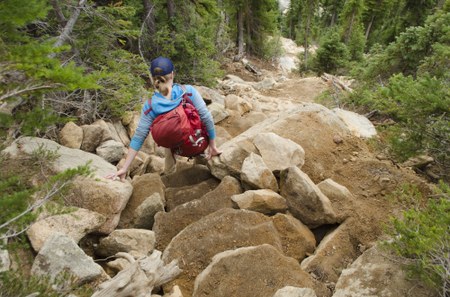
One of the most common concerns mountaineering clients have is how to keep their knees healthy as they add mileage and years. To strengthen your quadriceps for downhill hiking, add Reverse Step Ups and Backward Walking to your training program. Both moves will help you develop better balance and build your leg strength and confidence, no matter your age.
Reverse step up
Stand in front of a sturdy bench six to thirteen inches high, preferably in front of a mirror. Place the foot of your non-dominant leg on the step behind you, toes turned outward ten degrees. Square your hips and shoulders forward, with a hand on a wall or dowel to help balance. Slowly lift yourself onto the elevated leg as though you are walking upstairs backwards. As you lower back to the floor, watch your knee in the mirror. If it wobbles or buckles toward the midline, feels tentative, or if you lose your balance, lower the height and try again.
On each repetition, try to keep your knee tracking over the middle toe or slightly outward. Resist collapsing inward. Make sure the leg on the bench does the lifting rather than rebounding off the floor. Subsequent sets may feel more stable as the muscles adjust to the exercise. Perform three sets of eight to ten repetitions, twice a week, taking two seconds to lift and two seconds to lower. Add a backpack or hand weights or increase the height of the step to add difficulty.
Backwards walking
To see if backward walking might help, first walk ten steps forward and nine steps back (to return to the start). If you have no pain in either direction, find a flat area clear of traffic or obstacles and walk backward for thirty yards. Once you can walk forward and back six times without pain, look for a slight elevation and walk backward up the hill.
If you are comfortable walking forward 2.5-3 mph on a treadmill, set a flat treadmill to a reduced pace (perhaps 1.5-2 mph). Be sure to hold onto the handrails to get into position facing backward. As you get more comfortable and familiar with the exercise, gradually increase your speed to match your forward pace. For increased challenge, increase the treadmill elevation or walk backwards up a moderate hill. If you train outside, make sure the area is clear of roots, obstacles, and traffic. Consider training with a partner who can walk forward while you go backward, then switch.
Who can benefit?
Anyone rehabbing from knee surgery or recovering from lower extremity injuries (sprained ankles, Achilles tears, or shin splints) might find both exercises helpful. If you have tried ibuprofen, ice/heat treatments, time off from training, physical therapy, stretching, or strength training and are not satisfied with your results, try the reverse step up. Athletes who need to make quick changes in direction or run backwards (i.e. soccer players or skiers) or who need a cross-training option to supplement their sport may benefit from backward walking.
Why do they work?
The eccentric (lowering) phase of going downhill is usually what causes mountaineers the most knee discomfort. The Reverse Step Up mimics the downhill movement in a safe and controlled environment, with you in full control of height, weight, and support until your legs are stronger. Backward walking reduces the eccentric component of training on the knee joint, allowing the body to continue to increase cardiovascular capacity and strength endurance while healing.
This article originally appeared in our Spring 2019 issue of Mountaineer Magazine. To view the original article in magazine form and read more stories from our publication, click here.
 Courtenay Schurman
Courtenay Schurman